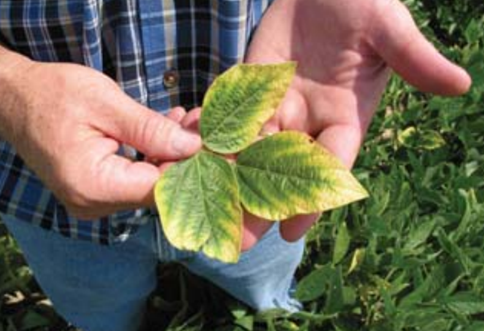
In-Season Potassium and Sulfur Fertility in Soybeans
In a corn-soybean rotation within the Midwest, soybeans can often be overshadowed by the focus on a strong nutrient management program for a corn crop. However, considering the yield potential and genetics in place today, soybean fertility programs need thoughtful consideration as well. We know that when it comes to nitrogen, soybeans are for the most part self-sufficient. Other nutrients like phosphorus, potassium, and sulfur need addressed. During peak growth, soybeans have been found to take up 0.7 pounds of P2O5, 3.4 pounds of K2O, and 0.3 lbs of S per day (Bender et al., 2015). The chart below shows the average nutrient needs and removal of a 60 bushel per acre soybean crop. Remember that when the grain is removed, those nutrients are removed from the field system and cannot be relied on for the next crop. It is important to fertilize accordingly and replace or increase the soil nutrient levels in order to provide for the subsequent crop needs.
Table 1. Nutrient Requirements and Removal for a 60 bushel per acre soybean crop
| Nutrient |
Required to Produce (acre-1) |
Removed with Grain (acre-1) |
Harvest Index (%) |
|
N |
245 | 179 | 73 |
|
P2O5 |
43 | 35 | 81 |
|
K2O |
170 | 70 | 46 |
|
S |
17 | 10 | 61 |
Bender et al., 2015 Agronomy Journal (107:563-573)

Let’s Look at Potassium Specifically.
Meeting the high potassium demand of soybeans in-season can become particularly problematic depending on climate conditions. Potassium is generally immobile in the soil. Plants take up potassium through root interception and primarily diffusion. Limited moisture conditions effect potassium uptake in two ways. First in drought conditions, root growth is reduced leading to less “scavenging” for potassium in the soil profile. Second, less water means less diffusion and movement of potassium to the root system for uptake thus reducing plant availability. On the other hand, when moisture is in great supply, potassium can be potentially lost from coarse textured soils. This is primarily concerning when potassium chloride has been applied and larger rainfall events occur. Deficiency symptoms of potassium in soybeans include yellowing of the leaf edges on older leaves. If the deficiency becomes severe, these symptoms will also be seen on the new leaf growth.
So how can we combat moisture influences on potassium availability in-season? Building an in-season liquid K program for your crop will help ensure adequate plant availability. Side-dressing liquid potassium in-season close to the plant, is a great way to provide readily available potassium when the crop needs it most. Where pivot irrigation is used, liquid potassium can be applied through pivot solutions in smaller frequent doses throughout the crop’s peak demand period, ensuring high availability. This is especially helpful in coarse textured soils. When drought conditions are present, foliar applications of potassium can also assist in meeting soybean K demands. Research has shown that foliar applications ranging from V4 to R2 can improve yield, particularly in drier environments. It is important to remember that even if your soil test K levels look to be adequate, it doesn’t mean that the potassium will be fully available all season long. When drought conditions occur, K uptake from the soil is largely hindered making in-season potassium applications more successful even in high K soils.

What About Sulfur?
Being an oilseed crop, sulfur is essential to optimal soybean production and quality as well. Sulfur is a key component of the amino acids needed for protein synthesis within the plant. It is also essential for nitrogen fixation and utilization within soybeans. As noted earlier, 17 pounds of S are required to produce a 60 bushel soybean yield and more would be required in higher yielding conditions. We know early season sulfur applications are critical to early planted soybeans as sulfur is less available in the soil during cooler temperatures. Soybeans that are deficient in sulfur often appear pale green to yellow in the uppermost leaves.
Looking at the graph, peak sulfur uptake occurs during the reproductive growth stages. This illustrates the importance of having sulfur available throughout the season and not just focusing on at-planting sulfur solutions. Including sulfur in a side-dress application, in low organic matter soils especially, ensures adequate sulfur availability in-season.
Figure 1. Sulfur Uptake Curve of Soybean. (Gaspar and Conley, 2016)

Product Solutions
Crop Vitality products KTS® and K-Row 23® can be applied as an in-season side-dress banded application or applied foliar to help meet soybean potassium and sulfur needs. KTS and K-Row 23 can also be applied through pivot irrigation. In general, 3-10 GPA of KTS or K-Row 23 is recommended for a soil applied side-dress application based on crop needs. For foliar applications in soybean, a rate of 0.5-2 GPA can be applied with adequate water for optimum coverage. Including a slow-release liquid nitrogen fertilizer like N-Sure in a foliar blend can also improve foliar nutrient absorption. It is best to make foliar applications in the morning or evening when temperatures are below 90 degrees to prevent foliar burn. A jar test is recommended to test compatibility with other products. Consult with your local agronomist or Crop Vitality Specialist to determine appropriate in-season crop nutrient plans.
Written by Dr. Elizabeth Lemings, Crop Vitality, Tessenderlo Kerley Agronomist
Contact a SpecialistReference:
Bender, R. R., J. W. Haegele, & F. E. Below. (2015). Nutrient uptake, partitioning, and remobilization in modern soybean varieties. Agronomy Journal, 107(2), 563-573.
Gaspar, A. and S. Conley. (2017). Soybean nitrogen and sulfur uptake, partitioning, and removal. Pioneer Research Update.
Motavalli, P., K. Nelson, F. Stevens, S. Phurahong. (2005). What about foliar K on soybeans? Fluid Journal.